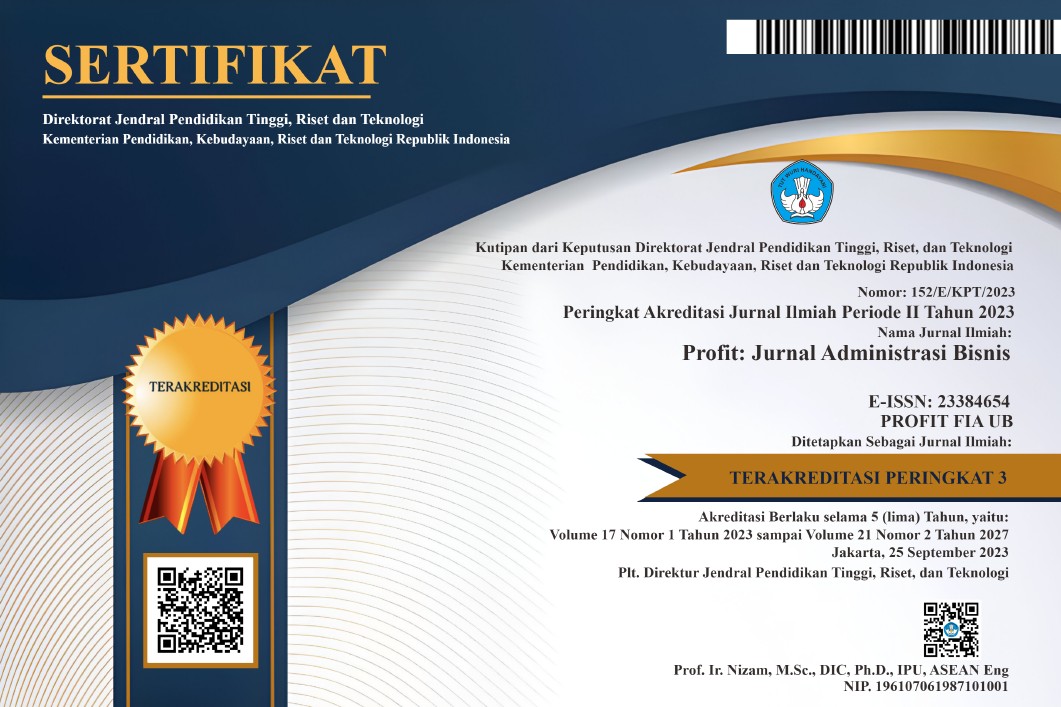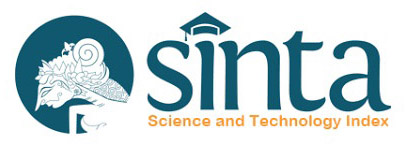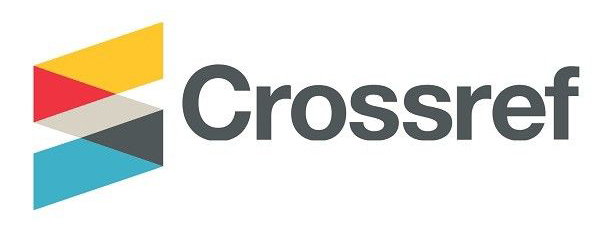ANALYSIS OF FACTORS THAT INFLUENCE EMPLOYEE PERFORMANCE (Study on Permanent Employees in Operational Section of PT WIMCycle Indonesia - Surabaya)
DOI:
https://doi.org/10.21776/ub.profit.2018.012.01.1Keywords:
performance, ability, motivation, leadershipAbstract
The purpose of this study was to describe and examine the factors that affect the performance of employees at PT. Wimcycle Indonesia Surabaya. These factors are grouped into 2 (two): the individual dimensions (abilities, work experience, motivation) and the organizational dimensions (leadership, communication, organizational climate), while for the variable employee performance is the result of work shown by employees at a certain time based on performance standards set. The research sample consisted of 90 employees that divided into several divisions. The questionnaire was developed by researchers using 5-point Likert scale. Data analysis techniques using descriptive statistics and multiple linear regression. Multiple linear regression model with six independent variables could explain 54.5% of the variation of the variable employee performance. Partially it can be seen that out of the six independent variables in this study, the capability of employees to have the most influence on employee performance.
Â
References
Azril, H.M.S., Jegak, U., Asiah, M., Azman A. Noor, Bahaman, A.S., Jamilah, O., and Thomas, K., (2010). Can Quality of Work Life Affect Work Performance among Government Agriculture Extension Officers? A Case from Malaysia. Journal of Social Sciences 6 (1): 64 – 73
Borman, W. C., M. A. Hanson, S. H. Oppler, E. D. Pulakos, L. A. White. (1993). Role of Early Supervisory Experience in Supervisor Performance. Journal of Applied Psychology Vol 78(3) 443–449.
Bowditch, J.L., and Buono, A.F., (1997) A Primer on Organizational Behavior. 4th edition, New York ; John Wiley and Sons, p. 120
Castilla, E. J. (2005). Social Networks and Employee Performance in a Call Center. American Journal of Sociology. 110(5) 1243–1283.
Chandan, Jit S. (2005). Organizational Behavior. New Delhi: Vikas Publishing House
Clampitt, P.G. & Downs, C.W. (1993). Employee Perceptions of the Relationship between Communication and Productivity: A field study. The Journal of Business Communication, 30(1), 5-28.
Colquitt, Jason A., Lepine, Jeffery A., and. Wesson, M. J., (2011). Organizational Behavior; Improving Performance and Commitment in the Work Place, Second Edition, New York: McGraw Hill – Irwin
Davis, K., and Newstroom, J. W. (1985). Organizational Behavior: Human Behavior at Work. New York, McGraw Hill
Davis, K. and Newstroom J.W. (2002). Organizational Behavior, International Edition (New York: The McGraw Hill Companies.
Dessler, G. (1997). Personnel Management. New Jersey: Prentice-Hall International, Inc.
Dokko, Gina., Wilk L. Steffanie and Rothbard P. Nancy. (2008). Unpacking Prior Experience : How Career History Affects Job Performance. Organization Science, Articles in Advance, pp. 1–18
Dubrin Andrew J.,(2005). Leadership (Translated), 2nd Edition, Jakarta: Prenada Media.
Ermaya Suradinata (1999), Pemimpin dan Kepemimpinan Pemerintahan [Leaders and Government Leadership]. Jakarta : PT. Gramedia Pustaka
Gibson, James L., John M. Ivancevich and James H. Donnelly, Jr. (1985). Organization Behavior: Structure, Process. PIano Texas: Business Publications Inc.
Glick W.H. (1985). Conceptualizing and measuring organizational and psychilogical climate: Pittals in multilevel research. Academy of Management Review
Gomes, F. Cardoso, (1995), Manajemen Sumber Daya Manusia [Human Resource Management], 1st Edition, Yogyakarta : Andi Ofset.
Goodnight, G. Thomas., Crary, Daniel R., Balthrop,Virgil W., and Hazen,Michael., (1974). The Relationship between Communication Satisfaction and Productivity, Role Discrepancy, and Need Level. Paper, International Communication Association convention, New Orleans, April 1974.
Greenberg J. & Baron R. A., (2003). Organizational Behavior, Eight Edition, International New Jersey: Pearson Education, Inc.
Hawkins, Brian L., and Penley, Larry E., (1978). The Relationship of Communication to Performance and Satisfaction. Paper, Academy of Management convention, San Francisco, August 1978.
Hersey, P., & Blanchard, K.H. (1988). Management of Organization Behavior: Utilizing Human Resources (5th ed.). Englewood Cliffs, NJ: Prentice-Hall.
Hill, Tosi., & Caroll, S.J, (1997). Organisational Theory and Management : A Macro Approach, New York : John willey and Sons Inc.
Ilyas, Y., (1999). Kinerja [Performance], 1st Ed., Publisher: Badan Penerbit FKM, UI, Depok.
Jain, Harrish.C. (1973). Supervisory Communication and Performance in Urban Hospitals. Journal of Communication, 23. 103-117.
Jewell & Siegall, M. (1990). Psikologi Industri Organisasi Modern [Modern organization of industrial psychology]. Jakarta: Arcan.
Kreitner, Robert and Kinicki, Angelo. (2007). Organizational Behavior, Seventh edition, New York : McGraw Hill - Irwin
Lattam, G.P., and C.C. Pinder (2005). Work Motivation Theory and Research at the Dawn of the Twenty-First Century. Annual Review of Psychology 56. Pp. 485 -516
Lok, P. & J. Crawford (2001). Antecedents of Organizational Commitment and the Mediating Role of Job Satisfaction. Journal of Managerial Psychology, Vol. 16, No. 8, pp. 594-613
Madlock, P.E., (2008). The Link Between Leadership Style, Communicator Competence and Employee Satisfaction. Journal of Business Communication January 2008 vol. 45 no. 1 61-78., 45: 61-78. DOI: 10.1177/0021943607309351
Mathis, Robert L. and Jackson, John H., (2001). Human Resource Management, 9th edition. South-Western College Publishing, Ohio, USA
Matin, Hassan Zarei., Jandaghi, Golamreza., Karimi, Fateme Haj., Hamidizadeh, Ali., (2010). Relationship between Interpersonal Communication Skills and Organizational Commitment (Case study : Jahad Keshavarzi and University of Qom, Iran). European Journal of Social Sciences – Volume 13, Number 3 (2010) pages 387 – 398
McDaniel, M. A., F. L. Schmidt, J. E. Hunter. (1988). Job Experience Correlates of Job Performance. Journal of Applied Psychology, Vol 73(2), May 1988, 327-330
Medoff, J. L., K. G. Abraham. (1980). Experience, Performance, and Earnings. The Quarterly Journal of Economics (1980) 95(4): 703-736.
Milkovich, George, T. And Boudreau, John, W. (1991). Human Resource Management. Boston : Irwin Home-wood
Mitchell, T.R. (1982), Motivation: New Direction for Theory, Research and Practice. Academy of Management Review, p.81
Pace R. Wayne and Don F. Faules. (2005). Komunikasi Organisasi: Strategi Meningkatkan Kinerja Perusahaan [Organizational communication: Strategies to increase firm performance]. Editor : Deddy Mulyana. Bandung : Remaja Rosda Karya
Pearce, C. Glenn, & Segal, Gerald J., (1998). Effects Of Organizational Communication Satisfaction On Job Performance And Firm Growth In Small Businesses. (accessed from http://www.sbaer.uca.edu/research/1998/SBIDA/98sbi178.txt on May 29th, 2011)
Pincus, D. (1986). Communication Satisfaction, Job Satisfaction, and Job Performance. Human Communication Research, 12(3), 395-419.
Quińones, Miguel A., Ford, J. Kevin, Teachout, Mark S. (1995). The Relationship between Work Experience and Job Performance: A Conceptual and Meta-Analytic Review. Personnel Psychology, Volume 48, Issue 4, pages 887–910, December 1995
Razek-Abdel, W.A., (2011). Factors Affecting the Effectiveness of the Job Performance of the Specialists Working in the Youth Care at Helwan University. World Journal of Sport Sciences 4 (2): 116 – 125
Robbins, S.P., (1996), Organizational Behaviour, Sevent Edition, Prentice Hall International, Inc.
Rodrigues, Nuno & Rebelo, Teresa (2009). Work Sample Tests: Their Relationship with Job Performance and Job Experience. Journal of work and organizational psychology, Vol. 25, n.° 1, 2009 - Pages. 47-58
Rodwell, John., Kienzle, Rene., and Shadur, Mark A., (1998). The Relationship among Workâ€Related Perceptions, Employee Attitudes, and Employee Performance: The Integral Role of Communications, Human Resource Management; Fall/Winter98, Vol. 37 Issue 3/4, p277, 17p.
Saetang, J., Sulumnad, K., Thampitak, P., Sungkaew, T., (2010). Factors Affecting Perceived Job Performance Among Staff: A Case Study of Ban Karuna Juvenile Vocational Training Centre for Boys. The Journal of Behavioral Science, Vol. 5, No.1, 33 – 45
Siagian, Sondang P., (1988), Organisasi Kepemimpinan dan Perilaku Administrasi [Organizational Leadership and Administration Behavior], Fifth Edition, Jakarta: CV. Haji Masagung.
Singh, J., W. Verbeke & G.K. Rhoads (1996). Do Organizational Practices Matter in Role Stress Processes? A Study of Direct and Moderating Effects for Marketing-Oriented Boundary Spanners. Journal of Marketing, Vo. 60, pp.69-86.
Sneed, Jeannie., Vivian ,Virginia., D’Costa, Ayres., (1987). Work Experience as a Predictor of Performance: A Validation Study, Sage Journal Online (accessed from http://ehp.sagepub.com/content/10/1/42.abstract)
Soekarno. (1997). Pengantar Teori Ekonomi Mikro, [Introduction of Micro Economy Theory] Jakarta: LPFE – UI.
Steers, Richard M. and Lyman W. Porter, (1991). Motivation and Work Behavior, New York: McGraw-Hill.
Stonner. James A.F., Edward Freeman, Gilbert R. Daniel. (1996). Manajemen [Management]. Jilid II, Jakarta: Prenhalindo
Supono. (1996). Manajemen Personalia [Personnel Management]. Yogyakarta: BPFE-UGM.
Syukur. (2001). Manajemen Sumber Daya Manusia [Human Resource Management], Jakarta: LP3ES.
Weiss, A., and Landau, H., (1985). On the Negative Correlation between Performance and Experience and Education. National Bureau of Economic Research, Working Paper Series No. 1613, Cambridge, p. 1 - 12
White, Candace., Vanc, Antoaneta., and Stafford, Gina (2008). Internal Communication, Information Satisfaction and Sense of Community: The Effect of Personal Influence. (Accessed from http://www.instituteforpr.org/files/uploads/White_Vanc_Stafford. pdf)
Downloads
Published
Issue
Section
License
The copyright of the received article shall be assigned to the journal as the publisher of the journal. The intended copyright includes the right to publish the article in various forms (including reprints). The journal maintains the publishing rights to the published articles.

This work is licensed under a
Creative Commons Attribution-NonCommercial 4.0 International License

















